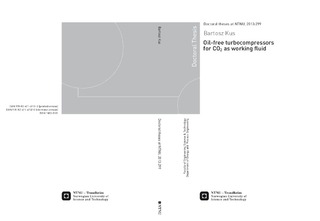| dc.contributor.author | Kus, Bartosz | nb_NO |
| dc.date.accessioned | 2014-12-19T11:51:39Z | |
| dc.date.available | 2014-12-19T11:51:39Z | |
| dc.date.created | 2014-01-10 | nb_NO |
| dc.date.issued | 2013 | nb_NO |
| dc.identifier | 687060 | nb_NO |
| dc.identifier.isbn | 978-82-471-4731-3 (printed version) | nb_NO |
| dc.identifier.isbn | 978-82-471-4732-0 (electronic version) | nb_NO |
| dc.identifier.uri | http://hdl.handle.net/11250/235418 | |
| dc.description.abstract | Compressing equipment can be found in almost every area of our industrialized society. Compressors drive our fridges, air conditioning systems and enable turbine engines to propel the aircrafts we use when going for holidays or a business trip. Without compressors an operation of virtually any conventional power plant providing electricity to our houses would not be possible. The compressor technology can therefore be regarded as a mature area of engineering with a vast theoretical and operational experience.
It may happen however that a traditional approach to certain new problems will not suffice, and alternative ways must be searched for. Such open-mindedness was required when the idea of introducing an oil-free compressor for a CO2 commercial refrigeration system was born. Initially, hermetic radial turbomachinery was identified as a potential candidate for this task. However, it turned out that rather special properties of carbon dioxide, compared to other common refrigerants, will result in challenges uncommon in turbomachinery found in other applications. While the initial technology choice still seemed feasible, high density of the CO2 at relevant operating conditions and significant rotational speeds required for a relatively small machine were indicating excessive levels of windage losses generated by the spinning rotor of the compressor.
It was decided to build a 1D tool for prediction of efficiencies for a wide range of machines based on a radial turbocompressor principle, but designed for CO2 applications with different operating pressures and capacities. The predictions of the tool were compared against numerical and experimental data. Good match was found. The 1D study revealed that high compression efficiencies, exceeding 70 %, are possible for the oil-free radial compressor concept in a relatively wide range of capacities provided that the inlet pressure is low, around 1 MPa, and that the pressure ratio is moderate, below 3. Potential for good efficiency is expected to deteriorate rapidly with increasing operational pressures due to windage losses. There is no obvious strategy for improvement of overall compressor efficiency when smaller capacities and close to supercritical pressures are in the focus. The major fraction of undesirable rotational losses is generated by the electrical motor. It can be reduced either by installing longer more slender motor or by reduction of rotational speeds. Efficiency improvement reached with application of a longer motor is shown to be of limited impact and is expected to be challenging from the rotordynamics point of view. Alternatively, multi-stage multi-shaft machine can be designed, but economic viability of such a strategy remains questionable.
Reduction of the compressor speed is not straightforward either, especially at low volumetric flows when low speeds would be detrimental to the impeller and diffuser efficiency. A non-standard approach introducing partially admitted radial machine was therefore proposed. A numerical analysis of a partially admitted compressor stage with a 16 cm impeller rotating at 13000 rpm is carried out.
Transient 2D simulations indicate more than 80% efficiency of the wheel at the total pressure ratio of around 1.4. To estimate the final stage efficiency, 3D effects such as the end-wall losses, the radial leakage, and the diffuser performance must be taken into account. A transient 3D analysis of the complete stage of the novel compressor has not been completed due to its time consuming nature. 3D simulations performed for various diffuser configurations indicate however that around 75% overall stage efficiencies might be possible. It would require further optimization of both blade and diffuser shapes. Comparison of non-stage losses, for both centrifugal and partial admission concepts, allow presuming that the novel machine could be superior in terms of the overall performance provided that comparable systems are characterized by close to supercritical mean operating pressures and capacities typical for commercial scale applications. To verify the initial insights of the present work, further research, including laboratory testing, is needed. | nb_NO |
| dc.language | eng | nb_NO |
| dc.publisher | Norges teknisk-naturvitenskapelige universitet, Fakultet for ingeniørvitenskap og teknologi, Institutt for energi- og prosessteknikk | nb_NO |
| dc.relation.ispartofseries | Doktoravhandlinger ved NTNU, 1503-8181; 2013:299 | nb_NO |
| dc.relation.haspart | Kus, Bartosz; Nekså, Petter. Development of one-dimensional model for initial design and evaluation of oil-free CO2 turbo-compressor. International journal of refrigeration. (ISSN 0140-7007). 36(8): 2079-2090, 2013. <a href='http://dx.doi.org/10.1016/j.ijrefrig.2013.05.009'>10.1016/j.ijrefrig.2013.05.009</a>. | nb_NO |
| dc.relation.haspart | Kus, Bartosz; Nekså, Petter. Oil free turbo-compressors for CO<sub>2</sub> refrigeration applications. International journal of refrigeration. (ISSN 0140-7007). 36(5): 1576-1583, 2013. <a href='http://dx.doi.org/10.1016/j.ijrefrig.2013.03.002'>10.1016/j.ijrefrig.2013.03.002</a>. | nb_NO |
| dc.relation.haspart | Kus, Bartosz; Nekså, Petter. Novel partial admission radial compressor for CO<sub>2</sub> applications. International journal of refrigeration. (ISSN 0140-7007). 36(8): 2065-2078, 2013. <a href='http://dx.doi.org/10.1016/j.ijrefrig.2013.07.015'>10.1016/j.ijrefrig.2013.07.015</a>. | nb_NO |
| dc.relation.haspart | Kus, Bartosz; Nekså, Petter. Numerical study of diffuser systems for a novel partial admissioncompressor using CO<sub>2</sub> as refrigerant. . | nb_NO |
| dc.title | Oil-free turbocompressors for CO2 as working fluid | nb_NO |
| dc.type | Doctoral thesis | nb_NO |
| dc.contributor.department | Norges teknisk-naturvitenskapelige universitet, Fakultet for ingeniørvitenskap og teknologi, Institutt for energi- og prosessteknikk | nb_NO |
| dc.description.degree | PhD i energi- og prosessteknikk | nb_NO |
| dc.description.degree | PhD in Energy and Process Engineering | en_GB |
